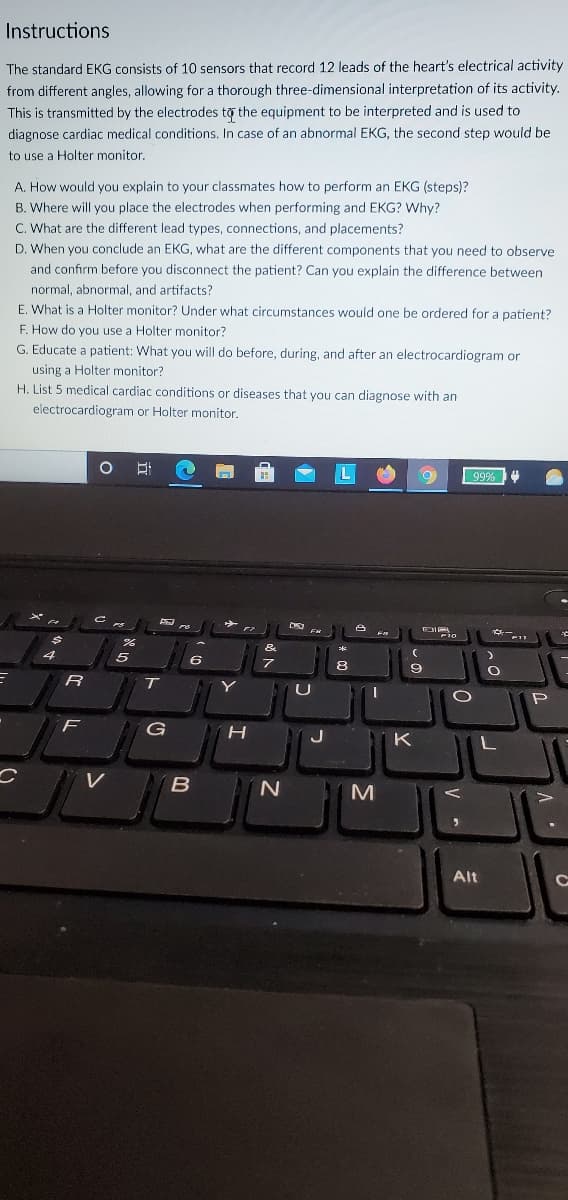How would you explain to your classmates how to perform an EKG (steps)? Where will you place the electrodes when performing and EKG? Why? What are the different lead types, connections, and placements?
How would you explain to your classmates how to perform an EKG (steps)? Where will you place the electrodes when performing and EKG? Why? What are the different lead types, connections, and placements?
Chapter13: Cpt Surgery Iii
Section: Chapter Questions
Problem 4MC
Related questions
Question
The standard EKG consists of 10 sensors that record 12 leads of the heart’s electrical activity from different angles, allowing for a thorough three-dimensional interpretation of its activity. This is transmitted by the electrodes to the equipment to be interpreted and is used to diagnose cardiac medical conditions. In case of an abnormal EKG, the second step would be to use a Holter monitor.
How would you explain to your classmates how to perform an EKG (steps)?
Where will you place the electrodes when performing and EKG? Why?
What are the different lead types, connections, and placements?
When you conclude an EKG, what are the different components that you need to observe and confirm before you disconnect the patient? Can you explain the difference between normal, abnormal, and artifacts?
What is a Holter monitor? Under what circumstances would one be ordered for a patient?
How do you use a Holter monitor?
Educate a patient: What you will do before, during, and after an electrocardiogram or using a Holter monitor?
List 5 medical cardiac conditions or diseases that you can diagnose with an electrocardiogram or Holter monitor.

Transcribed Image Text:Instructions
The standard EKG consists of 10 sensors that record 12 leads of the heart's electrical activity
from different angles, allowing for a thorough three-dimensional interpretation of its activity.
This is transmitted by the electrodes tỡ the equipment to be interpreted and is used to
diagnose cardiac medical conditions. In case of an abnormal EKG, the second step would be
to use a Holter monitor.
A. How would you explain to your classmates how to perform an EKG (steps)?
B. Where will you place the electrodes when performing and EKG? Why?
C. What are the different lead types, connections, and placements?
D. When you conclude an EKG, what are the different components that you need to observe
and confirm before you disconnect the patient? Can you explain the difference between
normal, abnormal, and artifacts?
E, What is a Holter monitor? Under what circumstances would one be ordered for a patient?
F. How do you use a Holter monitor?
G. Educate a patient: What you will do before, during, and after an electrocardiogram or
using a Holter monitor?
H. List 5 medical cardiac conditions or diseases that you can diagnose with an
electrocardiogram or Holter monitor.
99%
本一
F10
F11
4
9
Y
U
F
G
H
K
V
B
N
Alt
C
Expert Solution
This question has been solved!
Explore an expertly crafted, step-by-step solution for a thorough understanding of key concepts.
This is a popular solution!
Trending now
This is a popular solution!
Step by step
Solved in 4 steps

Recommended textbooks for you


Understanding Health Insurance: A Guide to Billin…
Health & Nutrition
ISBN:
9781337679480
Author:
GREEN
Publisher:
Cengage


Understanding Health Insurance: A Guide to Billin…
Health & Nutrition
ISBN:
9781337679480
Author:
GREEN
Publisher:
Cengage